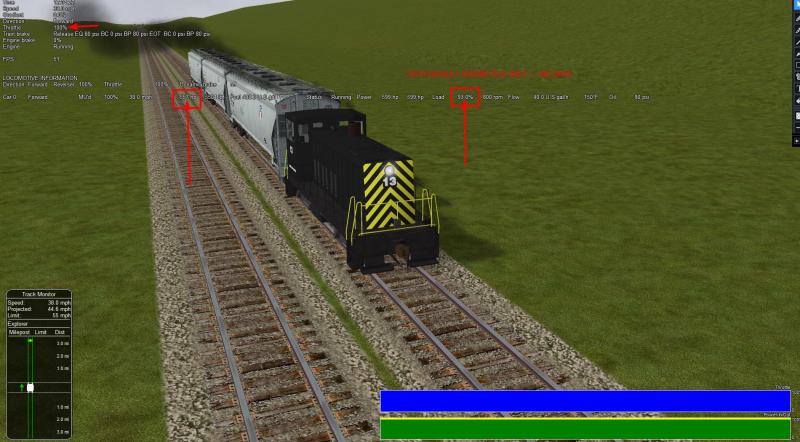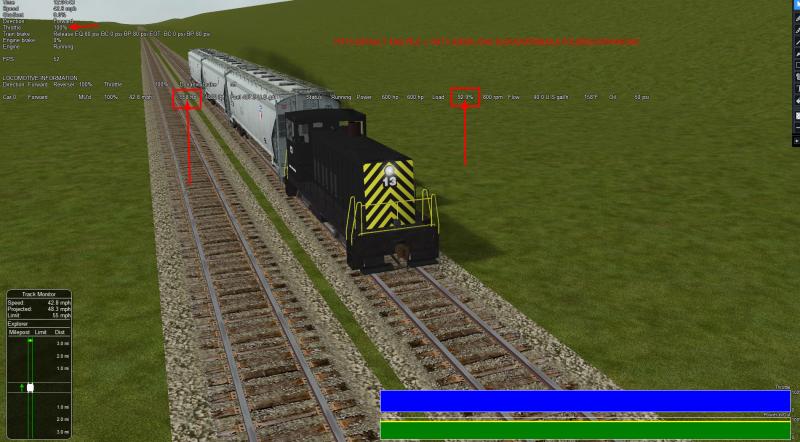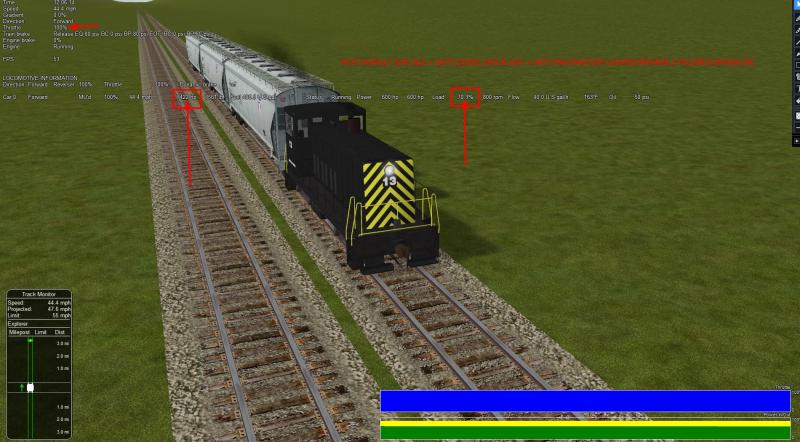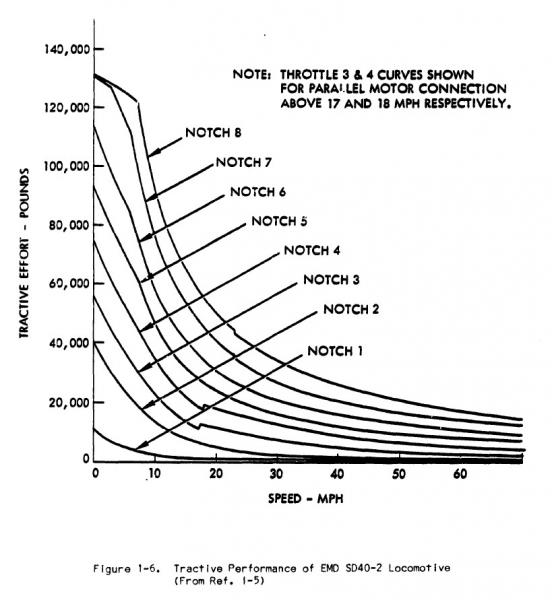1. Default MSTS eng file produces power to the rail - Notch8 - in the normal 90% range and is proportionally correct at all other power notches.
2. Default MSTS eng file with ORTSDieselEngines block ( via OpenRails folder/eng include file/Common.inc folder ) also produces normal power to the rails at Run 8 and proportionally correct at all other notches.
3. Adding the ORTSMaxTractiveForceCurves in any file configuration results in reduced power to the rails at Notch8, in the range of 50% (observed as low as 42% and as high as 70%), also proportionally lower at all other notches.**
4. All diesel locomotives tested, all routes, no log warning or error is observed.
5. Tests in the screenshot were with the locomotive and curve given in the manual on page 118, Sec. 8.1.4.1 ( see files used inserted in post )
**Note: file configurations --- MSTS default eng file with ORTSMTFcurves added to it ( No OpenRails folder); ORTSMTFcurves added to ORTSDieselEng block ( as shown Below) + MSTS default eng file; and ORTSMTFcurves only ( OpenRails folder/Common.inc) + MSTS default eng file.
Re-reading what I posted (and postings in another thread), I don't believe one can conclusively state that the fault lies with the ORTSMTF curves, it could very well be a problem with the Advanced Adhesion model. I'm thinking how to test that? Anyone know the advanced adhesion code?...that's not something I could tackle.
Comment ( Standard ORTS Diesel Engine for GE_70Ton Locomotive )
Comment ( Performance Ratings == Gross HP 700 == Traction HP 600 == 23605lb CTE == 41590lb MTE )
Comment ( include ( "..\\..\\Common.inc\\Locomotives\\GE_70Ton.inc" ) )
ORTSDieselEngines ( 1
Diesel(
IdleRPM ( 315 )
MaxRPM ( 800 )
StartingRPM ( 275 )
StartingConfirmRPM ( 350 )
ChangeUpRPMpS ( 65 )
ChangeDownRPMpS ( 35 )
RateOfChangeUpRPMpSS ( 25 )
RateOfChangeDownRPMpSS ( 15 )
MaximalPower ( 521.990kW )
IdleExhaust ( 1.2 )
MaxExhaust ( 2.3 )
ExhaustDynamics ( 2.2 )
ExhaustDynamicsDown ( 0.8 )
ExhaustColor ( 20161819 )
ExhaustTransientColor ( 40212324 )
DieselPowerTab (
0 0
350 55928
415 111855
480 167783
545 223710
610 279638
675 335565
740 391493
800 447420
)
DieselConsumptionTab (
0 0
315 37.9
800 151.4
)
ThrottleRPMTab (
0 315
12.5 350
25 415
37.5 480
50 545
62.5 610
75 675
87.5 740
100 800
)
DieselTorqueTab (
0 0
315 2951
800 23605
)
MinOilPressure ( 20 )
MaxOilPressure ( 50 )
MaxTemperature ( 120 )
Cooling ( 3 )
TempTimeConstant ( 720 )
OptTemperature ( 71 )
IdleTemperature ( 55 )
)
)
ORTS (
ORTSEmergencyCausesThrottleDown ( 1 )
ORTSWheelSlipCausesThrottleDown ( 1 )
ORTSMainResChargingRate ( 0.237 )
ORTSBrakePipeChargingRate ( 40 )
TrainPipeLeakRate ( 0.0833 )
ORTSEngineBrakeReleaseRate ( 38 )
ORTSEngineBrakeApplicationRate ( 34 )
ORTSBrakePipeTimeFactor ( 0.003 )
ORTSBrakeEmergencyTimeFactor ( 0.1 )
ORTSBrakeServiceTimeFactor ( 1.009 )
)
ORTSMaxTractiveForceCurves ( 0 ( 0 0 50 0 )
.125 (
0 23125
0.3 23125
1 6984
2 3492
5 1397
10 698
20 349
50 140 )
.25 (
0 46250
0.61 46250
1 27940
2 13969
5 5588
10 2794
20 1397
50 559 )
.375 (
0 69375
0.91 69375
2 31430
5 12572
10 6287
20 3143
50 1257 )
.5 (
0 92500
1.21 92500
5 22350
10 11175
20 5588
50 2235 )
.625 (
0 115625
1.51 115625
5 34922
10 17461
20 8730
50 3492 )
.75 (
0 138750
1.82 138750
5 50288
10 25144
20 12572
50 5029 )
.875 (
0 161875
2.12 161875
5 68447
10 34223
20 17112
50 6845 )
1 (
0 185000
2.42 185000
5 89400
10 44700
20 22350
50 8940 )
)
include ( "..\\bc13ge70tonner.eng" ) Wagon ( include ( "..\\..\\Common.inc\\Locomotives\\Std_TypeF_Coupler.inc" ) include ( "..\\..\\Common.inc\\Locomotives\\Std_Loco_Brakes.inc" ) ORTSAdhesion ( ORTSCurtius_Kniffler ( 7.5 44 0.161 0.7 ) ) ORTSAdhesion ( ORTSSlipWarningThreshold ( 70 ) ) ORTSBearingType ( Roller ) ORTSDavis_A ( 920.72 ) ORTSDavis_B ( 20.8947 ) ORTSDavis_C ( 5.485595 ) Comment ( == Assumptions -Locomotive diesel/electric - speed - 55mph (89km/h), Roller Bearing, 4 axles, frontal area - 10.6m2, WagonWeight - 63.5 ton (metric), Drag 0.90 == ) ) Engine ( Effects ( DieselSpecialEffects ( Exhaust1 ( -0.405 4.3 -0.417 0 1 0 0.13 ) ) ) include ( "..\\..\\Common.inc\\Locomotives\\GE_70Ton_TEST.inc" ) )

 Log In
Log In Register Now!
Register Now! Help
Help













